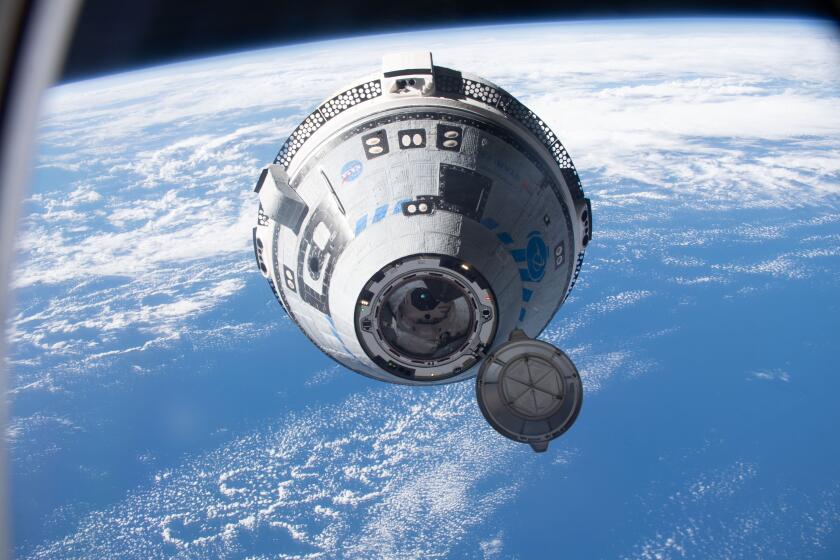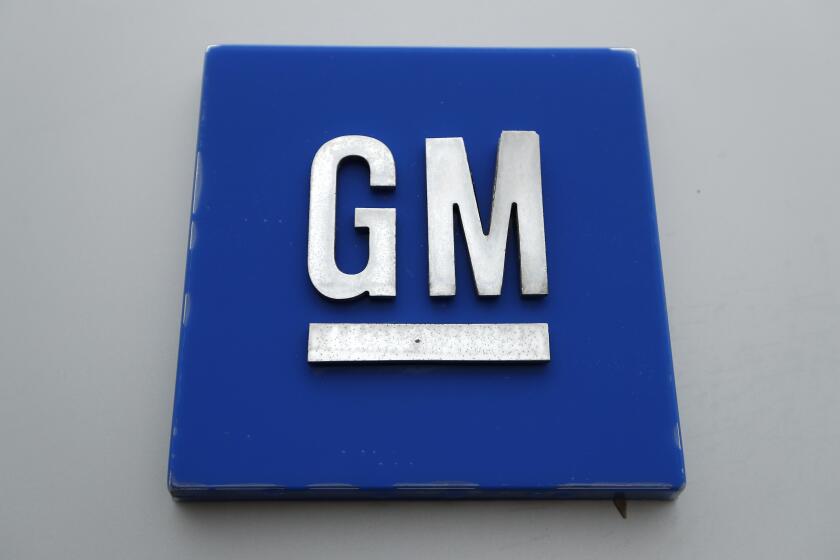SpaceX will bring Boeing’s Starliner astronauts home from the International Space Station

- Share via
SpaceX will bring home the two astronauts stranded on the International Space Station for the last two months because of troubles with Boeing’s Starliner spacecraft, NASA announced Saturday.
NASA Administrator Bill Nelson said the decision, which followed a formal review conducted Saturday, was driven by the agency’s commitment to safety, especially after the loss of 14 astronauts in the 1986 Challenger explosion and the 2003 Columbia disaster on its return to Earth.
“This whole discussion, remember, is put in the context of we have had mistakes done in the past,” Nelson said at a news conference at the Johnson Space Center in Houston. “Spaceflight is risky, even at its safest and even at its most routine. And a test flight by nature is neither safe nor routine.”
NASA may need to have SpaceX’s Crew Dragon capsule return two astronauts to Earth from the International Space Station due to problems with Boeing’s Starliner craft.
The decision by NASA to bring home astronauts Butch Wilmore and Suni Williams on SpaceX’s Crew Dragon capsule in February follows months of irregularities that have hobbled the third test flight of Boeing’s Starliner spacecraft — which began even before its June 5 launch.
The outcome is not only a blow to Boeing, whose Starliner program is years behind schedule, but to NASA, which awarded multibillion-dollar contracts to the company and rival SpaceX in 2014 to service the space station with crews and cargo.
Since 2020, Elon Musk’s Hawthorne company has ferried more than half a dozen crews there aboard its Crew Dragon capsule — while Boeing has managed only two remote flights before the one in June, including one in May 2022 that docked with the orbiting lab.
NASA said Saturday that the Starliner will now return to Earth remotely next month. The SpaceX mission that will bring Wilmore and Williams home is scheduled to blast off Sept. 24.
Gwynne Shotwell, SpaceX’s chief operating officer, responded to the announcement with a post on X, the social media platform owned by Musk. “SpaceX stands ready to support @NASA however we can,” she said.
Steve Stich, manager of NASA’s Commercial Crew Program, said the decision resulted from inconclusive ground tests that were conducted on the thrusters after they malfunctioned when Starliner docked with the space station June 6.
“As we got more and more data over the summer and understood the uncertainty of that data, it became very clear to us that the best course of action was to return Starliner uncrewed,” he said. “If we had a model, if we had a way to accurately predict what the thrusters would do ... I think we would have taken a different course of action.”
The problems that have plagued Starliner have been an embarrassment for Boeing, which is still grappling with an investigation into a door plug that blew out during a 737 Max 9 flight this year to Ontario International Airport in San Bernardino County. That followed the two crashes of its 737 Max 8 jets several years ago that severely damaged its reputation for safety.
Just this month, Boeing wrote off $125 million in expenses related to the Starliner program after previously booking some $1.5 billion in cost overruns.
Nelson said Saturday he informed Boeing’s new chief executive, Kelly Ortberg, of the decision, and that the executive committed to working with the agency to resolve the problems with Starliner. Nelson said that will give the agency the “redundancy” it has wanted to service the station.
In a statement Saturday, Boeing said, “We continue to focus, first and foremost, on the safety of the crew and spacecraft. We are executing the mission as determined by NASA, and we are preparing the spacecraft for a safe and successful uncrewed return.”
For years, NASA had to rely solely on Russia’s Soyuz craft to send U.S. astronauts to the station after the space shuttle program ended in 2011. NASA plans to continue to partner with the Russian program, which along with the U.S. was the primary builder of the orbiting lab that first launched in 1998.
The latest Starliner mission, which was expected to last about a week, was plagued with troubles.
The capsule was originally set to blast off May 6, but that flight was scuttled because of a malfunctioning valve on the Atlas V rocket that launches it into space. Additional launch dates were missed after a helium leak was found in the propulsion system that propels Starliner in space.
The helium pressurizes the system’s rocket fuel, but NASA and Boeing officials decided the leak was not serious and developed software fixes to work around it. However, the leak grew larger as the spacecraft approached and docked with the space station the next day.
More concerning was that the propulsion system’s thruster engines malfunctioned during the docking procedure.
Ground testing on an identical thruster NASA conducted last month found that Teflon used to control the flow of rocket propellant eroded under high heat conditions, while different seals that control the helium gas showed bulging.
NASA officials have maintained Starliner has 10 times more helium than it needs to return to Earth and the craft could be used if there were an emergency situation aboard the space station. This month Boeing issued a statement that cited all the testing that had been conducted and concluded, “Boeing remains confident in the Starliner spacecraft and its ability to return safely with crew.”
The aging space station is scheduled to be retired in 2030. In June, NASA awarded SpaceX an $843-million contract to build a craft that would nudge the station safely out of its orbit so it can burn up in the atmosphere, with any stray pieces landing in remote areas of the ocean.
The troubles afflicting Starliner mean that if it ever receives agency clearance to send crews to the space station, it will provide that service for far fewer years. Boeing, however, has said it wants to use the craft to service the commercial space station being developed by Jeff Bezo’s Blue Origin rocket company.
Unlike the Space X’s Crew Dragon capsule, which lands in water, Starliner will touch down in the Arizona or New Mexico desert in a parachute ground landing pioneered by the Soviets decades ago. That makes it easier to ready the reusable craft for another launch.
However, the propulsion system is jettisoned in space, so NASA and Boeing engineers will not have a chance to take it apart and examine exactly what went wrong.
More to Read
Inside the business of entertainment
The Wide Shot brings you news, analysis and insights on everything from streaming wars to production — and what it all means for the future.
You may occasionally receive promotional content from the Los Angeles Times.












